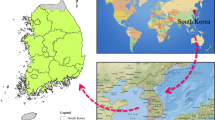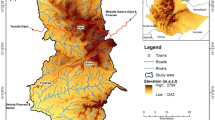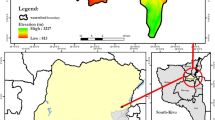Abstract
Universal Soil Loss Equation (USLE), originally developed by the USDA for agricultural lands and then used throughout the world, was applied in mountainous forest terrain in China. The woodland area was divide into 100 m × 100 m grid cells. The ArcInfo 9.2 GIS software provided spatial input data was used to predict the spatial distribution of the average annual soil loss on grid basis. The average rainfall erositivity factor (R) for national woodlands was found to be 21–1798 MJ·mm·ha−1·h−1·a−1. The soil erodibility factor (K) with a magnitude of 0.043 t·ha·h· ha−1·MJ−1·mm−1 is the highest for Chinese woodland. Most of the slope length factors (LS) were less than 5 for the national woodland. The highest and lowest values of cover and management factor (C) were found out to be 0.0068 and 0.2550 respectively for coniferous woodland and orchard woodland. The value of conservation factor (P) was assigned to be 1 for Chinese woodlands because of scarcity of conversation practice data at the national scale. The average annual soil loss of the national woodland areas was 3.82 t·km−2·a−1. About 99.89% of Chinese woodland area was found out to be under slight erosion class, whereas it only resulted in about 41.97% of soil loss under woodland area, and 58.03% of soil loss occurred under high erosion potential zone, namely more than 5 t·ha−1·a−1. Therefore, those zones need immediate attention from soil conservation point of view. The results here are consistent with many domestic and oversea previous researches under mountainous forests or hilly catchments, thus we showed that the USLE can be applied to estimations of soil erosion for Chinese woodlands at the national scale.
Similar content being viewed by others
References
Blanco H, Lal R (2008). Soil erosion under forests. In: Blanco H, Lal R, eds. Principles of Soil Conservation and Management. Berlin: Springer-Verlag, 321–344
Bu Z H, Dong Q R, Zhou F J, Zhang L W (1992). Preliminary study on new algorithm of erosivity factor of rainfall. Acta Pedologica Sinica, 29(4): 408–418 (in Chinese)
Dabral P P, Baithuri N, Pandey A (2008). Soil erosion assessment in a hilly catchment of north eastern India using USLE, GIS and remote Sensing. Water Resources Management, 22(12): 1783–1798
Descheemaeker K, Muys B, Nyssen J, Poesen J, Raes D, Haile M, Deckers J (2006). Litter production and organic matter accumulation in exclosures of the Tigray highlands, Ethiopia. Forest Ecology and Management, 233(1): 21–35
Dissmeyer G E, Foster G R (1980). A guide for predicting sheet and rill erosion on forest land. Technical Publication No. SA-TP 11USDAForest Service, Atlanta, GA
Elliot WJ (2004). WEPP internet interfaces for forest erosion prediction. Journal of the American Water Resources Association, 40(2): 299–309
Famiglietti J S, Rudnicki J W, Rodell M (1998). Variability in surface moisture content along a hillslope transect: Rattlesnake Hill, Texas. Journal of Hydrology, 210(1–4): 259–281
Fistikoglu O, Harmancioglu N B (2002). Integration of GIS with USLE in assessment of soil erosion. Water Resoures Management, 16(6): 447–467
Gyssels G, Poesen J, Bochet E, Li Y (2005). Impact of plant roots on the resistance of soils to erosion by water: a review. Progress in Physical Geography, 29(2): 189–217
Huang Y He, Lu C L, Fu Q, Shi Y Z, Xu J J (1993). Study on the soil loss prediction in Southeast Fuiian. Journal of Soil and Water Conservation, 7(4): 13–18 (in Chinese)
Kitahara H, Okura Y, Sammori T, Kawanami A (2000). Application of universal soil loss equation (USLE) to mountainous forests in Japan. Journal of Forest Research, 5(4): 231–236
Lee S (2004). Soil erosion assessment and its verification using the universal soil loss equation and geographic information system: A case study at Boun Korea. Environmental Geology, 45(4): 457–465
Liu B Z (1993). Estimation and distribution of rainfall erosive power index (R) in Weibei region. Journal of Northwest Forestry College, 8(2): 21–29 (in Chinese)
Lu X X, Shen R M (1992). A preliminary study on the values K of soil erosibihty factor. Journal of Soil and Water Conservation, 6(1): 63–70 (in Chinese)
Mao R, Meng G T, Zhou Y (2006). Mechanism of plant roots on soil erosion control. Research of Soil and Water Conservation, 13(2): 241–243 (in Chinese)
Millward A A, Mersey J E (1999). Adapting the RUSLE to model soil erosion potential in a mountainous tropical watershed. Catena, 38(2): 109–129
Moore I D, Burch F J (1986). Physical basis of the length-slope factor in the Universal Soil Loss Equation. Soil Science Society of America Journal, 50(5): 1294–1298
Özhan S, BalcI A N, Özyuvaci N, Hizal A, Gökbulak F, Serengil Y (2005). Cover and management factors for the Universal Soil-Loss Equation for forest ecosystems in the Marmara region, Turkey. Forest Ecology and Management, 214(1–3): 118–123
Pimentel D, Kounang N (1998). Ecology of soil erosion in ecosystems. Ecosystems, 1(5): 416–426
Poesen JWA, Verstraeten G, Soenens R, Seynaeve L (2001). Soil losses due to harvesting of chicory roots and sugar beet: An underrated geomorphic process? Catena, 43(1): 35–47
Renard K G, Foster G R, Weesies G A, McCool D K, Yoder D C (1997). Predicting Soil Erosion by Water: A guide to conservation planning with the Revised Universal Soil Loss Equation (RUSLE). Agriculture Handbook No. 703, US Department of Agriculture, Washington D C: 367–384
Renard K G, Freimund J R (1994). Using monthly precipitation data to estimate the R-factor in the revised USLE. Journal of Hydrology, 157(1–4): 287–306
Ruysschaert G, Poesen J, Verstraeten G (2005). Inter-annual variation of soil losses due to sugar beet harvesting in West Europe. Agriculture, Ecosystems and Environment, 107(4): 317–329
Roose E J (1977). Use of the universal soil loss equation to predict erosion in west Africa. In: Foster G R (1977). Soil erosion: prediction and control. Special Publication No. 21, Soil Conservation Society of America Ankeny, Iowa, 60–74
Sharply A N, Williams J R (1990). EPIC-Erosion productivity impact calculator: 1. Model Documentation. Technical Bulletin No. 1768. Washington D C: USDA Agricultural Research Service
Sheridan G J, Rosewell C J (2003). An improved Victorian erosivity map. Australian Journal of Soil Research, 41(1): 141–149
Shi Z H, Cai C F, Ding S W, Wang T W, Chow T L (2004). Soil conservation planning at the small watershed level using RUSLE with GIS: A case study in the Three Gorge Area of China. Catena, 55(1): 33–48
Singh G, Babu R, Narain P, Bhushan L S, Abrol I P (1992). Soil erosion rates in India. Journal of Soil and Water Convervation, 47(1): 97–99
Song Y, Liu L, Yan P, Cao T (2005). A review of soil erodibility in water and wind erosion research. Journal of Geographical Sciences, 15(2): 167–176
Sun G, McNulty S G (1998). Modeling soil erosion and transport on forest landscape. In: Winning Solutions for Risky Problems: Proceedings of 29th International Conference on Erosion Control Association, Reno, Nevada, February 16–20, 1998, 187–198
Tan B X, Li Z Y, Wang Y H, Yu P T, Liu L B (2005). Estimation of vegetation coverage and analysis of soil erosion using remote sensing data for Guishuihe Drainage Ba. Remote Sencing Technology and Application, 20(2): 215–220 (in Chinese)
Wagenbrenner J W, MacDonald L H, Rough D (2006). Effectiveness of Three Post-fire Rehabilitation Treatments in the Colorado Front Range. Hydrological processes, 20(14): 2989–3006
Wang W Z, Jiao J Y (1996). Qutantitative evaluation on factors influencing soil erosion in China. Bulletin on Soil and Water Conservation, 16(5): 1–20 (in Chinese)
Wang W Z, Zhang X K (1995). Distribution of rainfall erosivity R value in China I. Journal of Soil and Water Conservation, 9(4): 7–18 (in Chinese)
Wei W, Chen L, Fu B, Huang Z l, Wu D P, Gui L D (2007). The effect of land uses and rainfall regimes on runoff and soil erosion in the semiarid loess hilly area, China. Journal of Hydrology, 335(3–4): 247–258
Wischmeier W H, Johnson C B, Cross B V (1971). A soil erodibility nomograph for farmland and construction sites. Journal of Soil and Water Conservation, 26(5): 189–193
Wischmeier WH, Smith D D (1978). Predicting rainfall erosion losses-A guide to conservation planning. Agricultural Handbook No. 537. Washington D C, United States Department of Agriculture
Yang Z S (1999). A Study on erosive force of rainfall on sloping cultivated land in the northeast mountain region of Yunnan province. Scientia Geographica Sinica, 19(3): 265–270 (in Chinese).
Yin S, Xie Y, Nearing M A, Wang C (2007). Estimation of rainfall erosivity using 5- to 60-minute fixed-interval rainfall data from China. Catena, 70(3): 306–312
Yu R, Kang Q, Zhang Z X, Zhao X L (2006). Assessment of vegetation coverage factor in soil erosion based on multi-spectral image interpretation. Remote Sensing Information, 4(1): 12–16 (in Chinese)
Zhang J, Zhuang J, Su J, Nakamura H, Ishikawa H, Cheng P, Fu J, 2008. Development of GIS-based FUSLE model in a Chinese fir forest subcatchment with a focus on the litter in the Dabie Mountains, China. Forest Ecology and Management, 255(7): 2782–2789
Zhou F J, Chen M H, Lin F X, Huang Y H, Lu C L (1995). The rainfall erosivity index in Fujian province. Journal of Soil and Water Conservation, 9(1): 13–18 (in Chinese)
Zhou W F, Wu B F (2008). Assessment of soil erosion and sediment delivery ratio using remote sensing and GIS: a case study of upstream Chaobaihe River catchment, north China. International Journal of Sediment Research, 23(2): 167–173
Zhou Z, Shangguan Z P, Zhao D (2006). Modeling vegetation coverage and soil erosion in the Loess Plateau Area of China. Ecological Modeling, 198(1–2): 263–268
Author information
Authors and Affiliations
Corresponding author
Rights and permissions
About this article
Cite this article
Zhang, C., Xie, G., Liu, C. et al. Assessment of soil erosion under woodlands using USLE in China. Front. Earth Sci. 5, 150–161 (2011). https://doi.org/10.1007/s11707-011-0158-1
Received:
Accepted:
Published:
Issue Date:
DOI: https://doi.org/10.1007/s11707-011-0158-1




